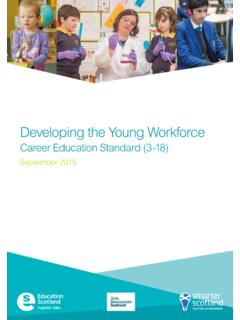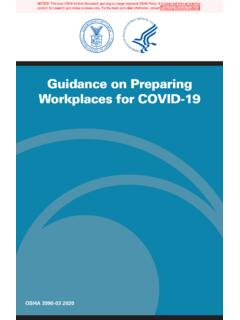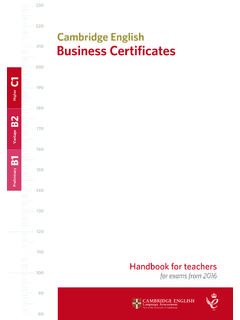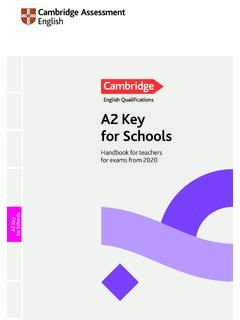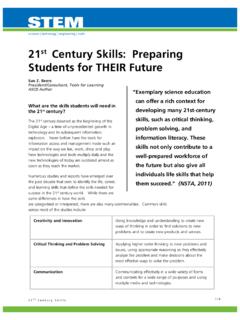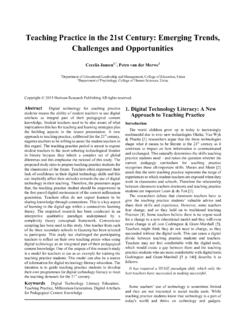Transcription of 1-Families Influences in Children’s Development and ...
1 Psychology Research, ISSN 2159-5542 December 2012, Vol. 2, No. 12, 693-705 Families: Influences in Children s Development and Behaviour, From Parents and Teachers Point of View Cl udia Rodrigues Sequeira de Figueiredo, Filomena Valad o Dias Instituto Universit rio de Psicologia Aplicada (IU); Research Unit in Psychology and Health (UIPES), Lisboa, Portugal Family plays a very important role in infant s Development and behaviour, being that the parents divorce can be a very stressful experience. This is an exploratory and comparative study that aims at identifying the differences in children s behaviour with divorced parents (or separated) and married parents (or living together), based on the parents and the teachers perceptions. The authors recruited a convenience sample of 62 children (30 with single parents, and 32 children with married parents) between six and nine years old.
2 To evaluate the parents perceptions about their children s behaviour, the Portuguese versions of the CBCL (Child Behaviour Check List) and the TRF (Teacher Report Form) for the teachers perceptions were used. According to the results obtained, teachers indicate single parents children as having more behavioural problems in two different dimensions than children with married parents; single parents children without siblings are pointed out as having more behavioural problems than the ones who do not, by their parents and the more spaced the visits of the father are, in single parents children, more behavioural problems they have, according to the mothers. Therefore, based on our results, teachers and parents indicate that divorce has a negative impact on children s behaviours. Keywords: family, divorce, infant s Development , behaviour Introduction Portugal was the country registering the highest number of divorces in the period between 1995 and 2004 among the 15 countries in Europe, divorces rising from 12,322 to 23,348, what means a rage around However, it does not mean that in Portugal people get more divorced than in other European countries, on the other hand, according to data from Eurostat (European Statistical Office), the divorce rate in northern EU (European Union) reached while in Portugal the rate was (Carneiro, 2006).
3 In the 1970s, divorce was recognized legally in Portugal and from that point on the divorce rate has been increasing: between 1975 and 1979, the average of divorces per year stood at 4,794 cases, in the 1980s, the divorce rate increases per year to 7,947 and in the 1990s divorces grew to 13,093 per year. In 2000/2001, the divorce rate has continued to increase (19,173) (National Institute of Statistics, 2001). Since divorce has become more common in societies, many authors showed interest in this phenomenon and the consequences of it in the family. Therefore, it may be pertinent to pay especially attention to any behaviour changes in children who are undergoing throw this change (parents divorce) and identify them so Cl udia Rodrigues Sequeira de Figueiredo, Master, Instituto Universit rio de Psicologia Aplicada (IU); Research Unit in Psychology and Health (UIPES).
4 Filomena Valad o Dias, Master, Instituto Universit rio de Psicologia Aplicada (IU); Research Unit in Psychology and Health (UIPES). DAVID PUBLISHING D FAMILIES: Influences IN CHILDREN S Development AND BEHAVIOUR 703that we can act immediately. In 1991, Amato and Keith examined 92 studies that compared the well-being of children whose parents had divorced with children whose parents were married to each other. This analysis and other studies in the 1990s came to the conclusion that children of divorced parents had lower results with regard to self-concept (Wenk, Hardesty, Morgan, & Blair, 1994, as cited in Amato, 2000), academic achievement (Astone & McLanahan, 1991; Teachman, Paasch, & Carver, 1996, as cited in Amato, 2000), some behavioural problems (Doherty & Needle, 1991; Simons & Associates, 1996, as cited in Amato, 2000), the adaptability (Forehand, Neighbors, Devine, & Armistead, 1994; Kurdek, Fine, & Sinclair, 1994, as cited in Amato, 2000), and health in the long run (Tucker et al.)
5 , 1997, as cited in Amato, 2000). Given that divorce is still a recent phenomenon, it is normal that the solutions and the adaptation of mentalities to the reality of divorce are not the best and most suitable to serve the best interests of the family (Ribeiro, 2007). Family Recent research about family defines its concept as a privileged environment of personality formation and bounding, therefore, it has a fundamental role in the Development of toddlers and adolescents (Berry, Kagit ibasi, Georgas, Poortinga, & Van de Vijler, 2006; Relvas & Vaz, 2007). The concept of family has been changing and suffering some important evolution concerning to sexual differentiation, biological factors, and the function of men and women at the symbolic and prohibitions. All of these matter the social evolution. These changings are going to have repercutions in the family structure as well as in its functioning (Bayle, 2005).
6 During a long time, the child occupied a periferic place in the family. However, as time goes by, the child becomes central in the family life (Leal, 2005). From the systemic theory, perspective family is a part of other contexts and systems which insert in cultural and communitarian contexts that affect the family behaviour (Relvas, 1996; Shaffer, 2005). The family is composed by small units, being the smallest the individual (Relvas, 1996). Family is a permeable system that is influenced by the context that suffers some variations with the level of family organization. Each family as a specific dynamism gives it a particular autonomy and individuality. Therefore, parents influence their children and children also influence their parents behaviour and educational practices. The family dynamic also changes with its members evolution (Shaffer, 2005). That said, if we want to know someone is a mother or a father, we have to observe them in the familiar dynamic (Relvas, 1996).
7 Some researchers pointed out that the most important role of the families is to transmit a social self. It is within the family that children have their first relationship experiences, therefore, family has a very important role in their children s social Development (Thomson, 1998, as cited in Laible, Carlo, Torquati, & Ontai, 2004; Jackson & Leonetti, 2001). Children s Behaviour and Development Nowadays, there is a huge worry concerning the Development and behaviour of children. Many authors studied this matter and we will briefly address some of these theories in which family play an important role. From a global perspective, children between six and 10 years old (the age of our sample) are in a consolidation face concerning the learnings acquired in the first childhood, preparing for adolescence. Around the age of six a great cognitive change happens, the child begins to understand the world around him/her, gaining skills to resolve problems, finding new solutions, learning to reflect, judge, and understand that others have a different point of view and that it can bring consequences to them and to the interaction between them.
8 FAMILIES: Influences IN CHILDREN S Development AND BEHAVIOUR 704 At this age, the child s life is pronounced by tensions between the child s autonomy and expectations that can or cannot stimulate his/her self-esteem (Eccles, 1999). Another important factor at this age is the beginning of school life. At this age, the child enters the preschool and starts spending more time at school and in other activities than with their parents, being also influenced by those who are at school ( , teacher and other children) (Eccles, 1999). Family role taken by some authors (Thomson, 1998, as cited in Laible et al., 2004; Jackson & Leonetti, 2001; Shaffer, 2005) has the primary agent of socialization, because it is within the family that children began to acquire values, attitudes, and behaviours accepted by society. Therefore, the socialization process has a way of children to learn beliefs, values, and social accepted behaviour (Shaffer, 2005; Laible et al.)
9 , 2004). It is within the family and in their intern relations that the child learns the basic rules of socialization, the values and duties, being the future behaviours and attitudes conciliated by this intern learning (Mead, 1970; Parsons, 1971; Michel, 1983; Sullerot, 1993; Strauss, 1997; Ginn & Arber, 1999, as cited in Relvas & Vaz, 2007). The experiences within the family are unique and make the relationship with parents and other family members critical to the child s social Development (Thompson, 1998, as cited in Laible et al., 2004). Once, the child is born, a process of individual Development starts within the family through learning habits, values, and language codes that make the child unique, different from all others. Therefore, the family context plays a fundamental role in the personality Development of children and adolescents (Ribeiro, 2007; Relvas & Vaz, 2007).
10 In short, it is through learning within the family and parenting, that the child develops socially and psychologically (Vaz & Relvas, 2007). The reality of family interactions can help the child to prepare himself/herself for the reality outside the family (Jackson & Leonetti, 2001). In the Brofenbrenner s perspective, the child has an active and passive role in its Development as this model emphasizes the importance of relationships among individuals and changes environments, leading to qualitative changes. Personal or environmental events ( , parental divorce) can lead to sudden qualitative changes. This is the theory of ecological systems, which describes the multiple levels of the environment that influence the Development of children and adolescents, a number of structures embedded in each other. There are four structures: (1) the micro-system that refers to the activities and interactions that occur in the immediate environment of the person and that gradually becomes more complex as the children come into contact with other contexts (day-care schools), of which family is always part of; (2) the meso-system that consists in the connections or interrelations among micro-systems such as school and pears; (3) the exo-system which includes the contexts in which children and adolescents are not part of but still exert some influence in their Development ( , parents working environment); and (4) the macro-system, the cultural context in which the micro-, meso-, and exo- system are embedded.











